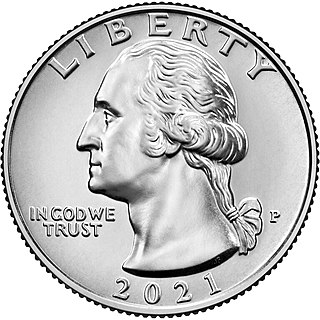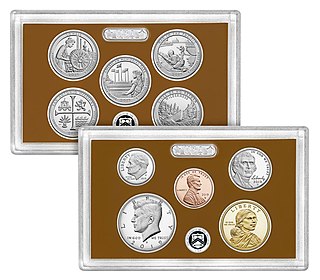
The quarter, short for quarter dollar, is a United States coin worth 25 cents, one-quarter of a dollar. The coin sports the profile of George Washington on its obverse, and after 1998 its reverse design has changed frequently. It has been produced on and off since 1796 and consistently since 1831.
Coins of the United States dollar were first minted in 1792. New coins have been produced annually and they make up a valuable aspect of the United States currency system. Today, circulating coins exist in denominations of 1¢, 5¢, 10¢, 25¢, 50¢, and $1.00. Also minted are bullion and commemorative coins. All of these are produced by the United States Mint. The coins are then sold to Federal Reserve Banks which in turn are responsible for putting coins into circulation and withdrawing them as demanded by the country's economy.

The United States Mint is a bureau of the Department of the Treasury responsible for producing coinage for the United States to conduct its trade and commerce, as well as controlling the movement of bullion. It does not produce paper money; that responsibility belongs to the Bureau of Engraving and Printing. The first United States Mint was created in Philadelphia in 1792, and soon joined by other centers, whose coins were identified by their own mint marks. There are currently four active coin-producing mints: Philadelphia, Denver, San Francisco, and West Point.
The United States Mint has minted numerous commemorative coins to commemorate persons, places, events, and institutions since 1848. Many of these coins are not intended for general circulation, but are still legal tender. The mint also produces commemorative medals, which are similar to coins but do not have a face value, and therefore are not legal tender.

The United States Bicentennial coinage is a set of circulating commemorative coins, consisting of a quarter, half dollar and dollar struck by the United States Mint in 1975 and 1976. Regardless of when struck, each coin bears the double date 1776–1976 on the normal obverses for the Washington quarter, Kennedy half dollar and Eisenhower dollar. No coins dated 1975 of any of the three denominations were minted.

The Eisenhower Commemorative silver dollar is a United States commemorative coin minted in 1990 to celebrate the 100th Anniversary of the birth of General/President Dwight D. Eisenhower. This coin is not to be confused with the Eisenhower dollar or the Eisenhower Presidential dollar which were regular issue American coins.

The West Point Mint is a U.S. Mint production and depository facility erected in 1937 near the U.S. Military Academy in West Point, New York, United States. As of 2019 the mint holds 22% of the United States' gold reserves, or approximately 54 million ounces. The mint at West Point is second only to the gold reserves held in secure storage at Fort Knox. Originally, the West Point Mint was called the West Point Bullion Depository. At one point it had the highest concentration of silver of any U.S. mint facility, and for 12 years produced circulating Lincoln cents. It has since minted mostly commemorative coins and stored gold.
In 1983 and 1984, the United States Mint issued a series of commemorative coins to commemorate the 1984 Summer Olympic games held in Los Angeles. These coins were authorized by Public Law 97-220.

In 2007, the United States Mint released a gold five-dollar commemorative coin which commemorates the 400th year after the founding of Jamestown. Surcharges from the sale of the Jamestown commemorative were donated to Jamestown-Yorktown Foundation of the Commonwealth of Virginia, the Secretary of the Interior and the Association for the Preservation of Virginia Antiquities to support programs that promote the understanding of the legacies of Jamestown.

The Washington quarter is the present quarter dollar or 25-cent piece issued by the United States Mint. The coin was first struck in 1932; the original version was designed by sculptor John Flanagan.

The Daniel Boone Bicentennial half dollar was designed by Henry Augustus Lukeman and minted during the 1934, commemorating the 200th birthday of frontiersman Daniel Boone. The obverse depicts Boone while the reverse depicts a frontiersman (Boone) standing next to an Indian Chief in front of a stockade on the left and the rising Sun on the right.

The United States Mint Proof Set, commonly known as the Proof Set in the United States, is a set of proof coins sold by the United States Mint. The proof set is popular with coin collectors as it is an affordable way to collect examples of United States coinage in proof condition.

The White House Bicentennial silver dollar is a commemorative silver dollar issued by the United States Mint in 1992.
The Lewis & Clark Bicentennial silver dollar is a commemorative silver dollar issued by the United States Mint in 2004. The coin portrays American explorers Meriwether Lewis and William Clark, the leaders of the 1804-1806 Lewis and Clark Expedition.

The Abraham Lincoln Bicentennial silver dollar is a commemorative coin issued by the United States Mint in 2009.
The Louis Braille Bicentennial silver dollar is a commemorative coin issued by the United States Mint in 2009.

The US Capitol Bicentennial silver dollar is a commemorative coin issued by the United States Mint in 1994.
The United States Constitution Bicentennial commemorative coins are a series of commemorative coins which were issued by the United States Mint in 1987.













